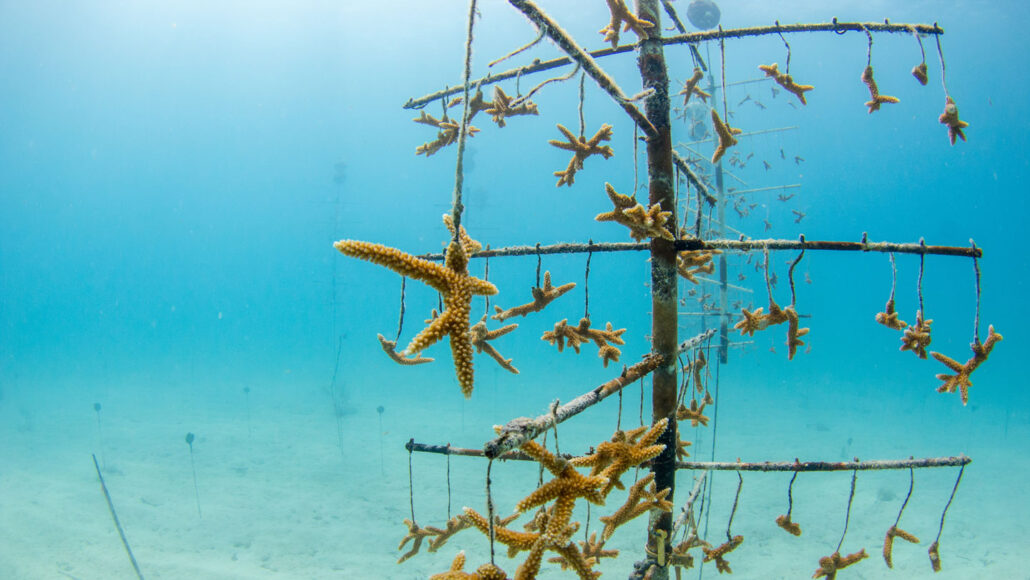Innovative Techniques to Preserve Coral Reefs: Fake Fog, Reskinning, and Sea-Weeding

Erinn Muller, a marine biologist, is working on the daunting task of examining the health of Florida's coral reefs, which have been ravaged by a combination of harsh heat, rising storm severity and lethal infections. Muller, who works with the Mote Marine Laboratory in Sarasota, Florida, reveals that the state has lost a staggering 98 percent of its living coral cover. Yet, the plight of Florida's reefs is not an isolated incident. From the iconic Great Barrier Reef in Australia to unassuming reefs in the Caribbean, coral ecosystems worldwide are witnessing a crisis.
Despite these grim facts, Muller refutes a defeatist attitude. She draws hope from ongoing innovative attempts to defend and restore the fragile coral reefs. The Caribbean king crab nursery project at Mote, led by reef restoration expert Jason Spadaro, is one such source of encouragement. At this facility, minuscule crab offspring are observed as they mature into salad-eating scavengers. Once released into neighboring reefs, the adult Maguimithrax spinosissimus species are known to consume the seaweed that is dangerously smothering the reefs.
Tali Vardi shares Muller's optimism. As a marine biologist and executive director of the Coral Restoration Consortium, a global community dedicated to the cause of coral reefs, Vardi believes that there is an impressive amount of effort being made to restore the distressed reefs. According to Vardi, although the survival of coral reefs largely depends upon slowing climate change, attempts are being made to "maintain pockets of biodiversity" that could potentially be the starting point for the long-term recovery of reefs.
Given the vast diversity of coral reefs, a variety of solutions is required to address the various challenges. As Vardi points out, there is no one-size-fits-all solution here. Consequently, coral experts worldwide are exploring a myriad of measures, ranging from basic seaweed removal to more complicated methods such as artificial fog production, all aimed at preserving the corals.
Another example of such an innovative project is on Australia's Great Barrier Reef. It isn't crabs but volunteers from the Earthwatch Institute, an international environmental organization, who are doing the weeding underwater. They dive and snorkel to remove macroalgae, hoping that their efforts will revive coral growth.
David Bourne, a marine biologist from James Cook University in Townsville, Australia, explains that corals lose their place when the natural balance in the reef ecosystem is disturbed, enabling macroalgae to dominate. He emphasizes that while hard corals may resemble a hybrid of plants and stones, they are essentially vast communities of small creatures called coral polyps. These polyps excrete a sturdy skeleton made of calcium carbonate, building an undersea colony on that framework. They also house tiny photosynthetic algae that impart the brilliant colors and produce energy for the corals.
Bourne discusses how seaweed poses a threat by absorbing light that could be used by corals and occupying space. If the number of corals decreases due to stressful factors such as heat or disease, the swift multiplication of seaweed can replace them.
To test the effectiveness of the Earthwatch's seaweed-removal program, volunteers removed over 2,148 kilograms of seaweed from 24 sections of the reef from 2018 to 2021. The results showed a remarkable recovery of the reef. Bourne regards sea-weeding as a practical method to change the competitive balance on the reef and foster coral growth. He hopes that the straightforward approach will gain more traction because it's accessible and relevant to everyone, particularly for reefs near the shore.
Lastly, though grim at first glance, the dead coral reefs serve an essential purpose by providing a structure for new corals to grow. By using coral microfragments, dead reefs can be "re-skinned" and the coral ecosystem, in a way, can be revived.
David Vaughan discovered the restorative potential of coral microfragments through what he calls a “eureka mistake.” Vaughan, formerly executive director of Mote and now head of the nonprofit Plant A Million Corals in Summerland Key, Fla., accidentally broke off shards of a branching coral while moving it to a new tank. Some coral polyps remained on the bottom of the tank. Vaughan assumed the tiny animals wouldn’t survive. But when he checked on them about two weeks later, he saw instead that they had quickly grown and multiplied.
Large corals grow slowly, Muller says, because they have to put a lot of energy into creating more of their calcium carbonate skeleton. If you instead affix multiple microfragments, consisting of a thin skeletal layer with a small bit of live coral tissue on top, near each other on a hard surface, they grow rapidly and fuse together. Mote scientists “hacked the biology of a lot of these slow-growing species to encourage them to put a lot of their resources into creating tissue faster,” Muller says.
A 2018 study found that microfragments of the mountainous star coral (Orbicella faveolata) grew 10 times as much tissue over a 31-month period as the normal, larger fragments that were previously used for reef restoration. For every square centimeter of coral that was planted at the beginning of the experiment, microfragments grew an average of 3.38 square centimeters of new tissue, while larger fragments grew only 0.35 square centimeters. Ocean plantings of coral microfragments have since withstood disease, bleaching and hurricanes, and grown large enough to reproduce within several years.
“Spawning after five years,” Spadaro says, “was definitely a game changer in terms of restoration.” Re-skinning with microfragments can give you functional reef ecosystems in a fraction of the time as previous methods. Mote scientists have since shared their knowledge with others working to restore corals around the world, such as in Hawaii and the Caribbean.
Bleaching is the dramatic outcome of great hardship; pushed to the brink by extreme stress, a strained coral belches out its symbiotic photosynthetic algae, turning stark white and losing its primary food source. Excessive heat is the most common culprit, but it’s not the only one.
Excess light can lead to bleaching, too, says Peter Butcherine, a biologist at Southern Cross University in Coffs Harbour, Australia. Too much light during photosynthesis, performed by the corals’ algae partners, leads to an abundance of toxic oxygen-containing molecules that are highly reactive and can cause cell death. Protecting corals from too much sun exposure can help prevent bleaching, but “you can’t roll out thousands of square meters of shade cloth” to shield an area the size of the Great Barrier Reef, Butcherine says.
Instead, Butcherine and others have turned to a more ephemeral approach: creating fog. “It’s essentially a sea mist,” Butcherine says. Though misting the entire Great Barrier Reef isn’t feasible, marine fog could be used to protect sensitive parts of the reef during the time of day when sunlight is at its harshest.
Butcherine and colleagues showed that shading corals for just four hours a day can delay bleaching even when water temperatures are high, such that corals could withstand three extra weeks of bleaching-level heat. The results of that laboratory study were published in the Sept. 20 Frontiers in Marine Science. This delay could help corals hold on to their algal partners until the environment around them cools.
Because it’s still being developed, marine fogging is quite expensive; it requires large arrays of misters mounted to ships. But Butcherine is excited by the potential of using solar power, including sun-powered drones mounted with misters, to implement the technique at a wider scale, and even at other reefs around the world.
“I’m optimistic that we can make a difference,” Butcherine says.
This article was supported by readers like you. Invest in quality science journalism by donating today.




